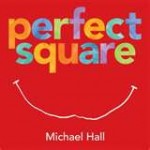 I fell in love with Perfect Square by Michael Hall when I first saw its vibrant, popsicle-colored pages. A square, with its four equal sides and four sharp corners, is perfectly happy, until it is cut into pieces and poked full of holes one Monday. But rather than groan about being ruined, the square takes its pieces and “made itself into a fountain that babbled and giggled and clapped.” On Tuesday, the square is torn to pieces that rearrange to make the flowers in a garden. Each day of the week, the square (painted in great swaths of colors that remind me of Eric Carle) is transformed, and the end of the story has a satisfying resolution that involves all the previous forms.
I fell in love with Perfect Square by Michael Hall when I first saw its vibrant, popsicle-colored pages. A square, with its four equal sides and four sharp corners, is perfectly happy, until it is cut into pieces and poked full of holes one Monday. But rather than groan about being ruined, the square takes its pieces and “made itself into a fountain that babbled and giggled and clapped.” On Tuesday, the square is torn to pieces that rearrange to make the flowers in a garden. Each day of the week, the square (painted in great swaths of colors that remind me of Eric Carle) is transformed, and the end of the story has a satisfying resolution that involves all the previous forms.
In preparation for my upcoming seminars, I’ve been spending a great deal of time studying the Common Core State Standards for kindergarten (if you, too, like spending evenings reading wordy documents about educational standards and benchmarks, check out corestandards.org) How do we teach the required standards and still include the books we love? Like this:
Share Perfect Square with your students. Read it first simply to enjoy a marvelous book. Read it again to the group and ask them about the wonderful vocabulary, “On Thursday, the square was shattered. What do you think shattered means? Let’s look at the picture.” Now we’re working on craft and structure, answering questions about unknown words. Take a picture walk through the book and have students explain what is happening. Now we’re integrating knowledge and ideas, hitting the kindergarten reading standard of linking the illustrations to the plot described in the words. Give students a square of colorful paper as an art extension activity to transform into something else. They’ll want to return to the book to see what author/illustrator Michael Hall did. Now we are actively engaging in group reading activities with purpose and understanding!
One cool story, three Common Core State Standards – all in a Perfect Square!
